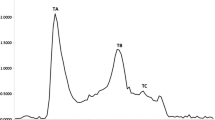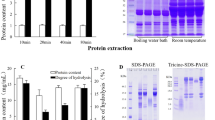Abstract
In the current study, two peptides with antioxidant properties were purified from skin protein hydrolysates of horse mackerel (Magalaspis cordyla) and croaker (Otolithes ruber) by consecutive chromatographic fractionations including ion exchange chromatography and gel filtration chromatography. By electron spray ionization double mass spectrometry (ESI-MS/MS), the sequence of the peptide from the skin protein hydrolysate of horse mackerel was identified to be Asn-His-Arg-Tyr-Asp-Arg (856 Da) and that of croaker to be Gly-Asn-Arg-Gly-Phe-Ala-Cys-Arg-His-Ala (1101.5 Da). The antioxidant activity of these peptides was tested by electron spin resonance (ESR) spectrometry using 1-diphenyl-2-picryl hydrazyl (DPPH·) and hydroxyl (OH·) radical scavenging assays. Both peptides exhibited higher activity against polyunsaturated fatty acid (PUFA) peroxidation than the natural antioxidant α-tocopherol. These results suggest that the two peptides isolated from the skin protein hydrolysates of horse mackerel and croaker are potent antioxidants and may be effectively used as food additives and as pharmaceutical agents.






Similar content being viewed by others
References
Ames BN (1983) Dietary carcinogens and anticarcinogens: oxygen radicals and degenerative disease. Science 221:1256–1264
AOAC (1991) Official methods of analysis, 16th edn. Association of Official Analytical Chemists, Washington, DC
Batista I, Ramos C, Coutinho J, Bandarra NM, Nunes ML (2010) Characterization of protein hydrolysates and lipids obtained from black scabbard fish (Aphanopus carbo) byproducts and antioxidative activity of the hydrolysates produced. Process Biochem 45:18–24
Bligh EG, Dyer WJ (1959) A rapid method of total lipid extraction and purification. Can J Biochem Physiol 37:911–917
Bougatef A, Nedjar-Arroume N, Manni L, Ravallec R, Barkia A, Guillochon D, Nasri M (2010) Purification and identification of novel antioxidant peptides from enzymatic hydrolysates of sardinelle (Sardinella aurita) by-products proteins. Food Chem 118:559–565
Butterfield DA, Castenga A, Pocernich CB, Drake J, Scapagnini G, Calabrese V (2002) Nutritional approaches to combat oxidative stress in Alzheimer’s disease. J Nutr Biochem 13:444–461
Byun HG, Lee JK, Park HG, Jeon JK, Kim SK (2009) Antioxidant peptides isolated from the marine rotifer, Brachionus rotundiformis. Process Biochem 44:842–846
Chandrasekhar K, Deosthale YG (1993) Proximate composition, amino acid, mineral and trace element content of the edible muscle of 20 Indian fish species. J Food Comp Anal 6:195–200
Chen HM, Muramoto K, Yamaguchi F (1995) Structural analysis of antioxidative peptides from soybean β-conglycinin. J Agric Food Chem 43:574–578
Chen HM, Muramoto K, Yamauchi F, Nokihara K (1996) Antioxidant activity of designed peptides based on the antioxidative peptide isolated from digests of a soy bean protein. J Agric Food Chem 44:2619–2623
Cheng Z, Ren J, Li Y, Chang W, Chen Z (2003) Establishment of a quantitative structure activity relationship model for evaluating and predicting the protective potentials of phenolic antioxidants on lipid peroxidation. J Pharm Sci 92:475–484
Dahl MK, Richardson T (1978) Photogeneration of superoxide anion in serum of bovine milk and in model systems containing riboflavin and amino acid. J Dairy Sci 61:400–407
Decker EA, Welch B (1990) Role of ferritin as a lipid oxidation catalyst in muscle food. J Agric Food Chem 38:674–677
Evans P, Halliwell B (2001) Micronutrients: oxidant/antioxidant status. Br J Nutr 85:67–74
Gill I, Lopez-Fadino R, Jorba X, Vulfson EN (1996) Biological active peptides and enzymatic approach to their production. Enzyme Microb Technol 18:162–183
Gordon M (2001) Antioxidants and food stability. In: Pokorny J, Yanishlieva N, Gordon M (eds) Antioxidant in food. CRC Press, New York, USA, pp 7–21
Halliwell B, Gutteridge JMC (1989) Free radicals in biology and medicine, 2nd edn. Clarendon Press, Oxford, pp 1–81
Huang X, Dai J, Fournier J, Ali AM, Zhang Q, Frenkel K (2002) Ferrous ion autoxidation and its chelation in iron-loaded human liver Hep G2 cells. Free Radic Biol Med 32:84–92
Ito N, Hirose M, Fukushima S, Tsuda H, Shirai T, Tatematsu M (1986) Studies on antioxidants: their carcinogenic and modifying effects on chemical carcinogenesis. Food Chem Toxicol 24:1099–1102
Jun SY, Park PJ, Jung WK, Kim SK (2004) Purification and characterization of an antioxidative peptide from enzymatic hydrolysate of yellow fin sole (Limanda aspera) frame protein. Eur Food Res Technol 219:20–26
Jung WK, Rajapakse N, Kim SK (2005) Antioxidative activity of low molecular peptide derived from the sauce of fermented blue mussel, Mytilus edulis. Eur Food Res Technol 220:535–539
Kapsokefalou M, Miller DD (1991) Effects of meat and selected food components on the valence of nonheme iron during in vitro digestion. J Food Sci 56(2):352–355
Klompong V, Benjakul S, Kantachote D, Shahidi F (2007) Antioxidative activity and functional properties of protein hydrolysate of yellow stripe trevally (Selaroides leptolepis) as influenced by the degree of hydrolysis and enzyme type. Food Chem 102:1317–1327
Lertittikul W, Benjakul S, Tanaka M (2007) Characteristics and antioxidative activity of Maillard reaction products from a porcine plasma protein–glucose model system as influenced by pH. Food Chem 100:669–677
Liu R, Wang M, Duan J, Guo J, Tang Y (2010) Purification and identification of three novel antioxidant peptides from Cornu bubali (water buffalo horn). Peptides 31(5):786–793
McCord JM (2000) The evolution of free radicals and oxidative stress. Am J Med 108:652–659
Mitsuta H, Yasumoto K, Iwami K (1996) Antioxidative action of indole compounds during the autoxidation of linoleic acid. Eiyo to Shokuryo 29:238–244
Nanjo F, Goto K, Seto R, Suzuki M, Sakai M, Hara Y (1996) Scavenging effects of tea catechins and their derivatives on 1,1,-diphenyl-2-picrylhydrazyl radical. Free Radic Biol Med 21:895–902
Osawa T, Namiki M (1985) Natural antioxidants isolated from eucalyptus leaf waxes. J Agric Food Chem 33:777–780
Peng X, Xiong YL, Kong B (2009) Antioxidant activity of peptide fractions from whey protein hydrolysates as measured by electron spin resonance. Food Chem 113:196–201
Pihlanto Leppala A (2001) Bioactive peptides derived from bovine whey proteins: opioid and ACE-inhibitory peptides. Trends Food Sci Technol 11:347–356
Pihlanto-Leppala A (2006) Antioxidative peptides derived from milk proteins. Int Dairy J 16:1306–1314
Pryor WA, Ann NY (1982) Free radical biology: xenobiotics, cancer, and aging. Acad Sci 393:1–22
Qian ZJ, Jung WK, Kim SK (2008) Free radical scavenging activity of a novel antioxidative peptide purified from hydrolysate of bull frog skin Rana catesbeiana Shaw. Bioresour Technol 99:1690–1698
Rajapakse N, Mendis E, Byun HG, Kim SK (2005) Purification and in vitro antioxidative effects of giant squid muscle peptides on free radical-mediated oxidative systems. J Nutr Biochem 16:562–569
Ranathung S, Rajapakse N, Kim SK (2006) Purification and characterization of antioxidative peptide derived from muscle of conger eel (Conger myriaster). Eur Food Res Technol 222:310–315
Roberts PR, Burney JD, Black KW, Zaloga GP (1999) Effect of chain length on absorption of biologically active peptides from the gastrointestinal tract. Digestion 60:332–337
Rosen GM, Rauckman EJ (1984) Spin trapping of superoxide and hydroxyl radicals. Methods Enzymol 105:198–209
Shabeena YN, Nazeer RA (2010) Antioxidant activity of hydrolysates and peptide fractions of Nemipterus japonicas and Exocoetus volitans muscle. J Aquat Food Prod Technol 19:182–192
Sherwin ER (1990) Antioxidant. In: Branen AL, Davidson PM, Salminen S (eds) Food additives. Marcel Dekker, New York, USA, pp 139–193
Suetsuna K (1998) Isolation and characterization of angiotensin I-converting enzyme inhibitor dipeptides derived from Allium sativum L. (garlic). J Nutr Biochem 9:415–419
Tang CH, Wang XS, Yang XQ (2009) Enzymatic hydrolysis of hemp (Cannabis sativa L) protein isolate by various proteases and antioxidant properties of the resulting hydrolysates. Food Chem 114:1484–1490
Thiansilakul Y, Benjakul S, Shahidi F (2007) Compositions, functional properties and antioxidative activity of protein hydrolysates prepared from round scad (Decapterus maruadsi). Food Chem 103:1385–1394
Wiseman H, Halliwell B (1996) Damage to DNA by reactive oxygen and nitrogen species: role in inflammatory disease and progression to cancer. Biochem J 313:17–29
Wu HC, Chen HM, Shiau CY (2003) Free amino acids and peptides as related to antioxidant properties in protein hydrolysates of markerel (Scomber austriasicus). Food Res Int 36:949–957
Xie Z, Huang J, Xu X, Jin Z (2008) Antioxidant activity of peptides isolated from alfalfa leaf protein hydrolysate. Food Chem 111:370–376
Yen GC, Chen HY (1995) Antioxidant activity of various tea extracts in relation to their antimutagenicity. J Agric Food Chem 43:27–32
Yildirim A, Mavi A, Oktay M, Kara AA, Algur OF, Bilaloglu V (2000) Comparison of antioxidant and antimicrobial activities of tilia (Tilia argentea Desf Ex DC), sage (Salvia triloba L.) and black tea (Camellia sinensis) extracts. J Agric Food Chem 48:5030–5034
Zhu K, Zhou H, Qian H (2006) Antioxidant and free radical-scavenging activities of wheat germ protein hydrolysates (WGPH) prepared with alcalase. Process Biochem 41:1296–1302
Acknowledgments
We gratefully acknowledge Dr. K. Ramasamy, Dean, School of Bioengineering, SRM University, for his support throughout the work. We extend our gratitude to the management, SRM University for providing the facilities.
Conflict of interest
The authors declare that they have no conflict of interest.
Author information
Authors and Affiliations
Corresponding author
Rights and permissions
About this article
Cite this article
Sampath Kumar, N.S., Nazeer, R.A. & Jaiganesh, R. Purification and identification of antioxidant peptides from the skin protein hydrolysate of two marine fishes, horse mackerel (Magalaspis cordyla) and croaker (Otolithes ruber). Amino Acids 42, 1641–1649 (2012). https://doi.org/10.1007/s00726-011-0858-6
Received:
Accepted:
Published:
Issue Date:
DOI: https://doi.org/10.1007/s00726-011-0858-6




